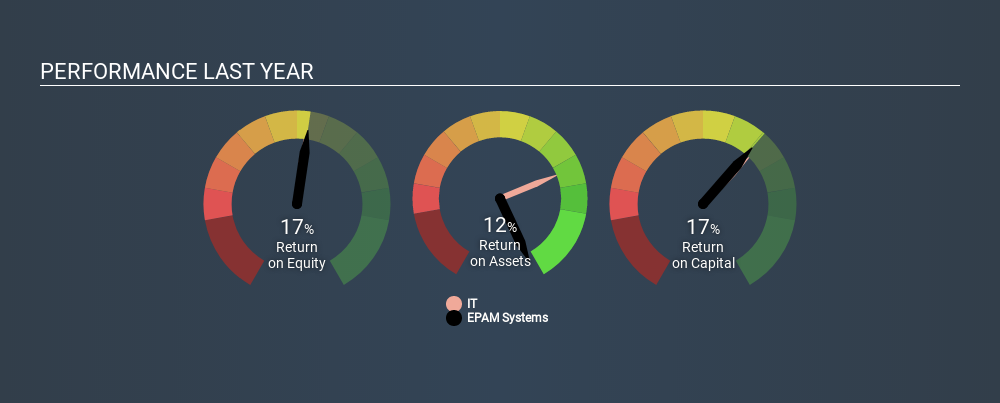
Today we'll look at EPAM Systems, Inc. (NYSE:EPAM) and reflect on its potential as an investment. Specifically, we'll consider its Return On Capital Employed (ROCE), since that will give us an insight into how efficiently the business can generate profits from the capital it requires.
Firstly, we'll go over how we calculate ROCE. Next, we'll compare it to others in its industry. Then we'll determine how its current liabilities are affecting its ROCE.
Return On Capital Employed (ROCE): What is it?
ROCE is a metric for evaluating how much pre-tax income (in percentage terms) a company earns on the capital invested in its business. Generally speaking a higher ROCE is better. In brief, it is a useful tool, but it is not without drawbacks. Author Edwin Whiting says to be careful when comparing the ROCE of different businesses, since 'No two businesses are exactly alike.
So, How Do We Calculate ROCE?
The formula for calculating the return on capital employed is:
Return on Capital Employed = Earnings Before Interest and Tax (EBIT) ÷ (Total Assets - Current Liabilities)
Or for EPAM Systems:
0.17 = US$326m ÷ (US$2.3b - US$389m) (Based on the trailing twelve months to March 2020.)
Therefore, EPAM Systems has an ROCE of 17%.
Check out our latest analysis for EPAM Systems
Does EPAM Systems Have A Good ROCE?
ROCE is commonly used for comparing the performance of similar businesses. EPAM Systems's ROCE appears to be substantially greater than the 10% average in the IT industry. I think that's good to see, since it implies the company is better than other companies at making the most of its capital. Regardless of where EPAM Systems sits next to its industry, its ROCE in absolute terms appears satisfactory, and this company could be worth a closer look.
You can see in the image below how EPAM Systems's ROCE compares to its industry. Click to see more on past growth.

When considering ROCE, bear in mind that it reflects the past and does not necessarily predict the future. Companies in cyclical industries can be difficult to understand using ROCE, as returns typically look high during boom times, and low during busts. This is because ROCE only looks at one year, instead of considering returns across a whole cycle. What happens in the future is pretty important for investors, so we have prepared a free report on analyst forecasts for EPAM Systems.
How EPAM Systems's Current Liabilities Impact Its ROCE
Current liabilities are short term bills and invoices that need to be paid in 12 months or less. Due to the way the ROCE equation works, having large bills due in the near term can make it look as though a company has less capital employed, and thus a higher ROCE than usual. To counter this, investors can check if a company has high current liabilities relative to total assets.
EPAM Systems has current liabilities of US$389m and total assets of US$2.3b. Therefore its current liabilities are equivalent to approximately 17% of its total assets. Low current liabilities are not boosting the ROCE too much.
Our Take On EPAM Systems's ROCE
This is good to see, and with a sound ROCE, EPAM Systems could be worth a closer look. EPAM Systems looks strong on this analysis, but there are plenty of other companies that could be a good opportunity . Here is a free list of companies growing earnings rapidly.
If you like to buy stocks alongside management, then you might just love this free list of companies. (Hint: insiders have been buying them).
Love or hate this article? Concerned about the content? Get in touch with us directly. Alternatively, email editorial-team@simplywallst.com.
This article by Simply Wall St is general in nature. It does not constitute a recommendation to buy or sell any stock, and does not take account of your objectives, or your financial situation. We aim to bring you long-term focused analysis driven by fundamental data. Note that our analysis may not factor in the latest price-sensitive company announcements or qualitative material. Simply Wall St has no position in any stocks mentioned. Thank you for reading.
About NYSE:EPAM
EPAM Systems
Provides digital platform engineering and software development services worldwide.
Very undervalued with flawless balance sheet.
Similar Companies
Market Insights
Community Narratives



